Artificial grass is presented as a solution to the demands of a lawn without the complications of natural grass. However, the former does not quite meet the expectations of many, allowing the world’s stadiums to come up with a new solution: hybrid grass.
This is a combination of natural grass and synthetic grass with an installation system patented by Desso Sports Systems.
What is hybrid turf?
It is a combination of artificial turf and natural turf. This combination looks and feels like natural grass, but at the heart of it are the artificial turf fibres. This type of grass is not seen in public places, nor in private gardens or terraces as it is more suitable for places such as football, baseball and rugby pitches.
Uses
Premier League camps such as Camp Nou, the Stade de France, the Santiago Bernabeu and many others use this model of grass. It began to be used in the 1990s as it was needed to meet the demands that were emerging in the British city of Huddersfield in relation to football and rugby pitches.
In this situation, it was imperative to find a solution so that the ground would withstand the extreme activities of these sports much longer. However, it was not until 2010 that it started to be used internationally, appearing for the first time in a big event such as the World Cup in South Africa.
Why do big stadiums switch to hybrid grass?
The first football pitches were made of earth and only some of them could play on natural grass since the maintenance of this has always been expensive.
Football is changing, improving and adapting to the new times and taking advantage of the technologies available today, a solution has been found in artificial turf to improve the playability on it. Worldwide, fields with this type of grass have been gaining ground, although despite their advantages and virtues, their acceptance is not total.

Features
One of the fundamental characteristics of artificial turf is its resistance, which translates into economic savings and a quick disposition of the land to be used immediately.
It has better traction, professional players who have played on it have stated that mobility on the turf is greater. The two previous characteristics allow a very good stability, which gives the opportunity to enjoy a much firmer and more stable ground, therefore it also allows to enjoy a better game.
Advantages of artificial hybrid grass
- The combination of the two grasses brings out the best in each, becoming a provider of stability and firmness to the pitch and the game.
- Players feel more stable when performing their sporting activities on this type of surface.
- The mixed grass surface has natural properties, being vegetal it becomes a healthier surface, allowing players not to suffer injuries from falls.
- Its durability, resistance and less maintenance make it a profitable product.
- Thanks to technological advances, hybrid grass is easy to install and its use does not require waiting.
- The structure of the turf and its properties inherited from the artificial turf make maintenance simple and easy.
- It is so strong that it provides three hours more play time than other types of grass.
How to install a hybrid turf
- The first step is to start the study of the land, gather the team of specialists and owners of the club to establish the needs to cover the effects of the climate, the intensity of use and its applications.
- The base soil is prepared, the drainage system pipes are dug and installed, the top layer is prepared with enriched sand and fertilizer.
- In this step the natural grass is sown. The application of the rolls in which the grass comes, also known as sod, may be carried out.
- The synthetic fibres are installed using a computer-controlled machine from Desso Sports Systems. The machine inserts 20 million synthetic fibres into the ground at a depth of 20 cm and a distance of 2 cm, leaving it 2 cm above the ground.
- In this step the fusion between the synthetic fibres and the grass begins, the roots begin to grow and become entangled around the synthetic fibres, thus fixing the artificial grass and leaving a firm ground ready for play.

Hybrid grass in Spain
In the 2016 – 2017 season, the Camp Nou will start using hybrid grass and will no longer be one of the world’s stadiums with natural grass. It has been known from official sources of FC Barcelona that players like Leo Messi, Andres Iniesta and Luis Suarez have tested the new ground of the Camp Nou.
FC Barcelona spent a year studying various options and finally decided to use the hybrid surface provided by the Desso company.

